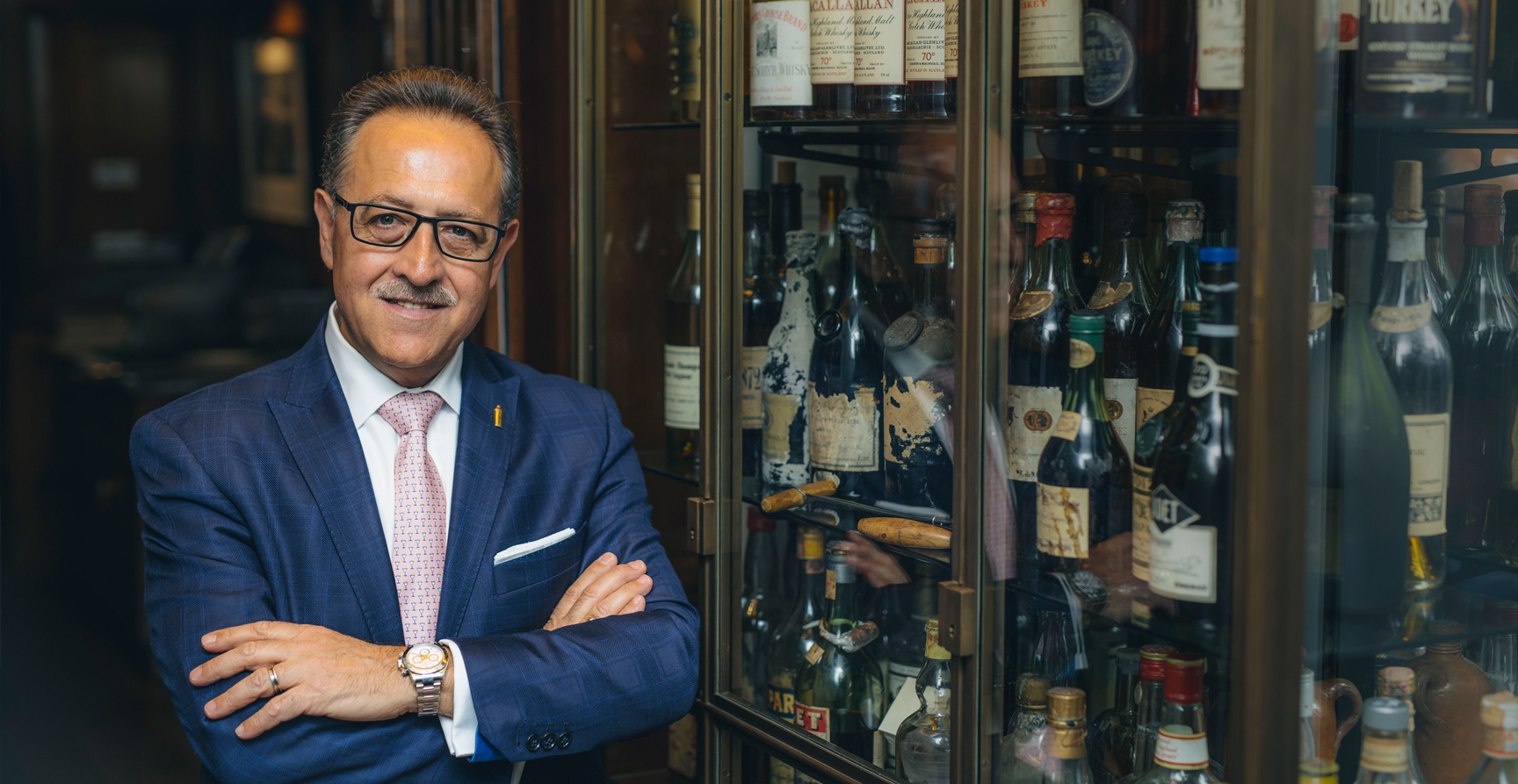“The difference between cognac and armagnac? Imagine a length of velvet and another of a silk fabric. Stroke them. The velvet has a deep, rich texture. That is an armagnac. The silk is pure finesse, and that, to me, is a cognac.”
– Salvatore Calabrese
Salvatore has a passion for Cognac. In particular, the vintage Cognacs in the historic, dust-covered bottles that only get to see the light of night when the occasion calls for a very special moment.
Here he shares with us his expertise and love for cognac and what he calls Liquid History.

Tasting Cognac
I agree with that grand old man of Cognac, Monsieur Bernard Hine, when he says that tasting is something you do with all five senses.
“You taste with your eyes, nose, mouth and hand,” he explained to me during lunch one day at the house that bears his name. “Feeling the glass is important and, if you are clever, you can also taste with your ears as you clink your glass against a friend’s as you wish each other luck!”
A romantic view from a passionate man! Tasting a fine Cognac is a pleasure to be taken seriously. There is a common accepted perception that 80% of the appreciation of Cognac is taken in via the nose. In my opinion, the perfect harmony of nose and palate is necessary, because it is the palate that distinguishes the Cognac’s strength, age and character.
After five years in the oak, the Cognac will be more brilliant yellow than amber. It will be sweet and mellow, all the flavours will be better combined, floral hints will be present, and fruit will make an appearance, usually reminiscent of apricot jam.
After ten years, the colour will have progressed from bright yellow to a more mature and soft golden yellow. The aromas will be well-balanced and harmonious. Wooden aromas merge with vanilla; hints of port-like characteristics appear, and an aroma of dried flowers will be present.
A further five years turns the Cognac a light, golden brown. Its’ aromas are rich and full, as are its’ flavours. The port and woody vanilla aromas are more intense. There is a softness and a balance to the composition and the dried flower tones are mixed with spices such as pepper, cinnamon and cloves.
Cognacs of twenty and thirty years in age feature floral fragrances at their best, and the woody aroma has departed.
The Tasting Stages
STAGE 1
Appearance
The first stage of tasting by a professional he or she notes the Cognac’s appearance, then positions his or her nose a few centimetres away from the rim of the glass.
|
STAGE 2
Aroma
The second stage of tasting comes when the Cognac is swirled in the glass, and the nose moves closer to the rim. More intense flavours and aromas hit the taster.
|
STAGE 3
Taste
The third stage involves the act of sipping, therefore tasting the liquid.

The House of Delamain blenders sum up the tasting stage as follows; “When a great Cognac develops its aromatic complexity in the glass, one can truly say it is playing an olfactory score. It would be a shame to miss this performance by drinking the Cognac too fast.”
In an old Cognac especially, the fragrance is so powerful that it stays with you in your throat, then starts to develop on the palate. Above all, it is important to develop a taste memory of aromas and flavours, then choose which most closely matches anything stored in this memory bank. That way you will learn to distinguish one aroma from another.
Qualities of Cognac
Three Star / VS –
this denotes the youngest cognac is three years old.
VSOP or Very Special Old Pale –
the youngest cognac is at least six years old Napoléon, Grand Reserve and Extra.
Vielle –
the youngest cognac is at least six years old XO: the youngest cognac is usually at least 15 years old.

A grand old Cognac is full of subtle nuances. As one afficiando put it, “Not all women can afford to go to Dior, yet everybody is going to be talking about what Dior did in its last fashion show. It is the same for vintages. You have to understand that vintages are our milestones, our memories of the past.”
My greatest pleasure is to open a bottle of vintage Cognac to see a golden liquid as lively as the day it was bottled. Uncorking a bottle is an emotional experience, especially if it is from an historic year. This brings me to the story of Winston Churchill, England’s wartime hero, who, when given a glass of vintage Bual 1792 during a visit to Madeira, cried out, “Do you realise, gentlemen, that when this was made, Marie Antoinette was still alive?”
It is this tremendous, tingling excitement that I try to pass onto a guest when I open a bottle for them. For when you look at a painting by Picasso, you can see the art of creation. Within a bottle of vintage Cognac lies the unseen art of distillation.
In my concept of Liquid History, I set out to match the historical year with the Cognac produced in that year. For me, a bottle of 1812 vintage Cognac immediately conjures up Napoleon’s retreat from Russia. Some 550,000 troops went into Moscow and only 22,000 returned. This was an historic year indeed. And I found a bottle or two…
Besides a love of history, there is another aspect to this passion of mine. Any Cognac produced before 1872/1873 has been made with pre-phylloxera grape varieties such as Colombard and Folle Blanche. To me, this represents a taste of grapes that are descended from the same rootstock originally planted by the Romans. A pre-phylloxera Cognac tastes more intense, more floral, with a hint of chocolate and a sweetness on the finish. To taste a Cognac from this year is to have a unique moment to savour. My moments include the enjoyment of an 1824 Courvoisier, an 1800 Bignon, and an 1810 Massouges.
Some notable vintage Cognacs with historic significance include:
|
1 8 0 5
Nelson was killed on the Victory during the defeat of the Spanish Armada and the French navy.
Napoleon declared himself King of Italy.
|
1 8 1 5
Andrew Jackson defeats the British at New Orleans on January 8, after the Civil War ends.
|
1 8 4 3
McKinley, the 25th American President (and the 5th from Ohio) was born.
|
1 8 4 4
Samuel F. B. Morse opens the telegraphic link between Baltimore and D.C.
|
1 9 1 4
The Year of the Lady – so-called because it was the first year of the War in Europe and women were replacing men in the fields and were even distilling the eau-de-vie.

“After you make your blend, you put it always in the old barrel to sleep and become aged. And you have just not to shake it. He is an old man. He is living his life.”
– Jacques Riviere, Cognac blender
“Making great Cognac is easy. All you need is a great-grandfather and a father who have dedicated their lives to it.”
– Jean-Paul Camus, House of Camus


